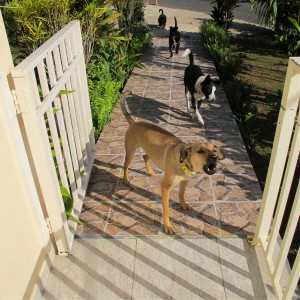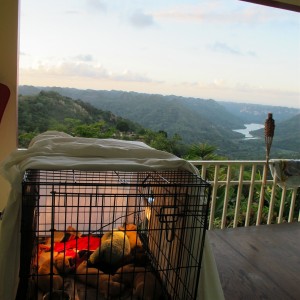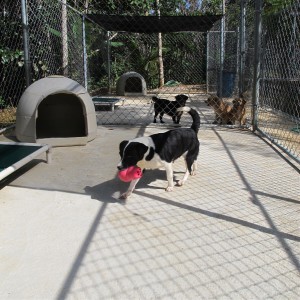Pets Alive works to provide sustainable solutions for Puerto Rico’s “satos”
 If you’ve been to Puerto Rico, you’ve surely seen them: stray dogs the locals call satos. You can spot them everywhere, trotting in the heat alongside roads from San Juan to Mayagüez and loitering on the periphery of seemingly every beach, parking lot, gas station and cluster of homes. Most are badly malnourished, with protruding hipbones and rib cages; some have coats patchy with mange, and they stagger from illness or injury. All too many are followed by litters of scrawny puppies.
If you’ve been to Puerto Rico, you’ve surely seen them: stray dogs the locals call satos. You can spot them everywhere, trotting in the heat alongside roads from San Juan to Mayagüez and loitering on the periphery of seemingly every beach, parking lot, gas station and cluster of homes. Most are badly malnourished, with protruding hipbones and rib cages; some have coats patchy with mange, and they stagger from illness or injury. All too many are followed by litters of scrawny puppies.
By now, even those who have never visited the 3,500-square-mile island are aware of its teeming population of strays (estimated at between 100,000 and 200,000). Recent news stories, which have exposed the southeastern dumping ground of Playa Lucia—better known as “Dead Dog Beach”—and the 2007 Barceloneta massacre, when 80 dogs were thrown to their deaths from a 50-foot bridge, are myriad and awful.
However, this coverage has had at least one positive consequence: a proliferation of stateside-based organizations dedicated to rescuing satos. At least a half-dozen such groups now exist, and most work in a similar way: they collect as many strays as possible, nurse them back to health on the island, then fly them to mainland U.S. shelters for adoption. Through their efforts, they have given hundreds, perhaps thousands, of dogs new homes.
In the past year, however, a new dog rescue operation, Pets Alive Puerto Rico, has been expanding this conventional approach to the sato problem. As well as rehabilitating strays and sending them north for adoption (through the New York–based headquarters of its parent organization, Pets Alive), this group has launched new on the ground programs: educational outreach in Puerto Rican communities, low-cost spay-and-neuter programs and even a B&B that attracts a steady stream of traveling volunteers. Their aim is to address the issue where it lives.
Pets Alive Puerto Rico (PAPR) has no published address. The six-acre sanctuary sits at the end of a long, unmarked dirt driveway, off the winding main road that snakes through the mountain village of Utuado. On the drive there, banana palms and crimson thatches of bougainvillea line the roadsides; hairpin turns offer sweeping views over the Rio Dos Bocas—a shimmering river far below, bound by jungly-green slopes and low-hanging clouds.
Joy and Ken Carson, who have run the no-kill sanctuary since opening it in April 2012, greet visitors with an apology for the hard-to-follow driving directions. They keep their location under the radar, says Joy, because they try to avoid having locals abandon dogs on the property. It’s tough to stay incognito with up to 50 barking dogs on site, however. The parcel of land, which was purchased with a donation from Rob and Marisol Thomas through their Sidewalk Angels Foundation, was chosen in part for its remoteness.
A tour of the sanctuary reveals a highly shipshape operation. The resident dogs, which range from adoptable adults to week-old orphaned pups who need bottle-feeding every few hours, occupy three separate areas on the property, each with spacious, immaculate kennels protected by sun shades, and containing Kuranda beds and “dogloos” for shelter. It’s important to have separate zones, the Carsons point out, because newly rescued dogs are often in precarious health and must be sequestered from those who aren’t yet vaccinated. (During a recent visit, one set of kennels housed a litter of pups who were slowly recovering from a bout of parvo.) The Carsons’ days are taken up with providing basic care for the dogs—cleaning their enclosures, changing and laundering their bedding, feeding and watering them, giving them medicine.
Not only have they rescued and rehabbed more than 350 dogs in just over a year, they have also managed to do an impressive amount of community outreach in the region around Utuado. By knocking on doors, promoting their work on social media and hosting educational seminars at area schools, they are establishing PAPR as a trusted resource for locals concerned about the satos’ welfare. (Area residents often tip off the couple about dogs in need.) They have also launched a pilot spay/neuter-release program, which, once it’s funded, will help ensure that even unadoptable strays won’t continue to reproduce.
The efforts the Carsons are most proud of, however, have been the partnerships PAPR has formed with local veterinarians to offer the community low-cost spay/neuter programs. After months of engaging with locals, they realized that—contrary to popular belief—many Puerto Ricans were perfectly willing to sterilize their dogs (and even neighborhood street dogs) as long as they could do so affordably. With the help of charitable foundations (including Cold Noses and the Humane Society International), they arranged for a veterinary clinic in the nearby coastal town of Arecibo to offer spay/neuter procedures at a greatly reduced cost ($50 rather than the usual $150 to $250).
 These efforts culminated with PAPR’s participation last February in World Spay Day, during which volunteer vets working with the organization spayed and neutered more than 150 dogs in a single week. Since then, Joy says, they have continued to arrange sterilization for between five and 10 local dog owners each week.
These efforts culminated with PAPR’s participation last February in World Spay Day, during which volunteer vets working with the organization spayed and neutered more than 150 dogs in a single week. Since then, Joy says, they have continued to arrange sterilization for between five and 10 local dog owners each week.
While the amount of day-in, day-out work to be done at PAPR is daunting, the Carsons have been able to entice a steady stream of volunteers to help out, largely through what may be their most unusual program of all: offering the extra bedrooms in the sanctuary’s cheerful main building—which also happens to be their house—to paying guests who want to take a do-gooding Puerto Rican B&B holiday. Joy says that since last April, about 35 volunteers have done brief stints (usually about a week) at the property, during which they share not just chores, but meals and nightly happy hour with their ever-welcoming hosts (Ken makes a mean rum-and-guava cocktail).
The work is undeniably arduous; there is always poop to be scooped, vet trips to be made, and Sisyphean heaps of dirty towels and blankets to launder. Still, several guests have already made repeat visits.
“It’s the puppy breath!” says Ken, using his favorite all-purpose description of the rewards that come from sanctuary work. Relentless though it may be, the work definitely allows plenty of time for petting, snuggling and playing with swarms of wriggling, grateful dogs. (Volunteers who’ve never before bottle-fed a litter find out pretty quickly just how magical puppy breath really is.)
“It may not be the most relaxing holiday you’ll ever take,” Ken quips. For dog lovers, though, it might easily be one of the most gratifying.

